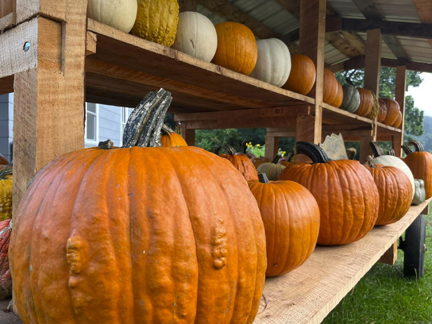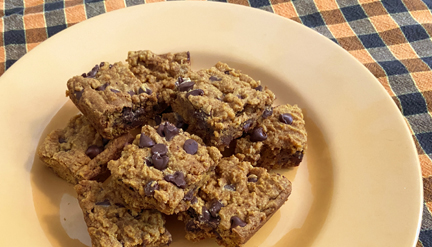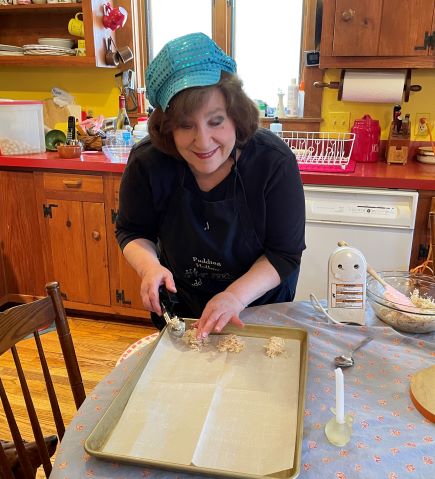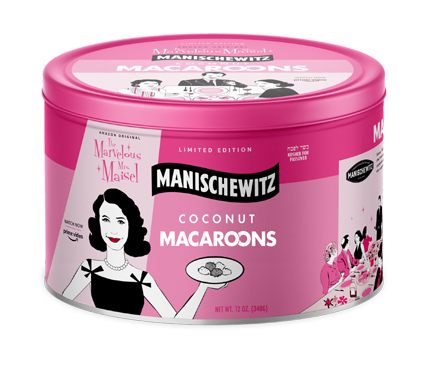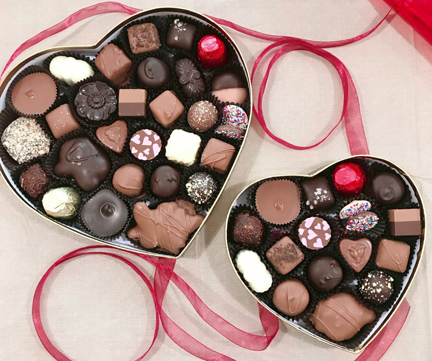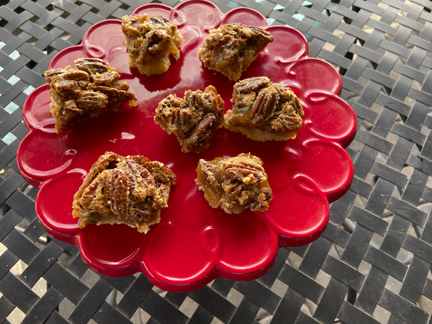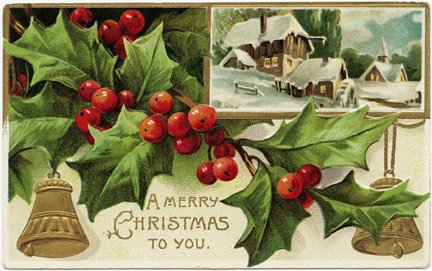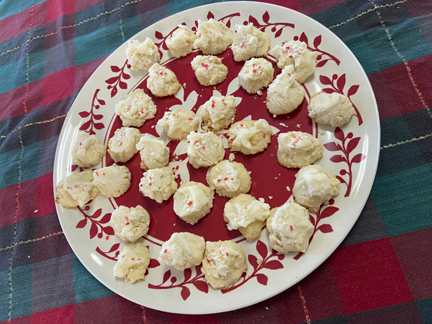
It may seem odd to provide a cookie recipe after Christmas, which is the day of days for cookies. If you’re like me, however, you’ll entertain friends and give gifts all the way until New Year’s Day and perhaps until Epiphany. I hope this recipe sweetens the extended season for you and your companions.
I was first served Peppermint Meltaways long ago by a friend. Since then, I have thought about making them—but I never actually got around to it until last week, when I found myself with a huge number of mini-candy canes.
I had ordered them to share at the office but had accidentally ordered two containers of candy canes instead of the one the office needed. I thus faced a surfeit of peppermint.
I recalled that the Meltaways featured crushed candy canes as a topping. I must admit that the recipe didn’t use as many candy canes as I had hoped—but it used some, and the people to whom I served the cookies were very happy indeed. I’m consequently sharing the recipe with you.
I have always adored peppermint, particularly at this time of year. I tried recently to find out why peppermint is so popular at Christmas, but no one (at least no one who inhabited that arcane source of information, the World Wide Web) seemed to know.
I did discover that the first candy canes, in the 19th century, were apparently a solid white confection not flavored with peppermint; the addition of stripes and that special flavoring came in the 20th century.
I also learned that peppermint is an ancient medicinal herb. Its name comes from Greek mythology. According to lore, the god Hades fell in love with a nymph named Minthe.
His wife, Persephone, discovered their affair and in a fit of rage turned poor Minthe into a plant that would grow wild and get trampled underfoot. (Personally, I think Persephone should have taken her wrath out on Hades instead, but I imagine he was a more formidable foe than the poor nymph.)
Hades altered Persephone’s spell slightly. He couldn’t return Minthe to her former form, but he made the plant she had become smell sweet so that people would think well of her.
The best explanation I could find for the popularity of peppermint at this time of year comes from the digital media company known as Tasting Table. An article posted there reminds readers that at this time of year we tend to indulge in an awful lot of food.
Mint aids digestion. Consequently, Tasting Table dubs it “the Official Digestif of the Holiday Season.”
Whether I love peppermint for its digestive properties or just for the way it perks up my palate, it definitely appeals to me. I am despondent if I can’t find peppermint-stick ice cream during the holiday season.
Luckily, in the area in which I live, it is manufactured by a number of ice-cream makers, but I purchase it early in December just in case stores run out later.
I should warn you that these cookies are a bit challenging, so much so that I almost decided to post a completely different recipe this week. As I noted earlier, however, the people who ate them adored them so I went with the original recipe.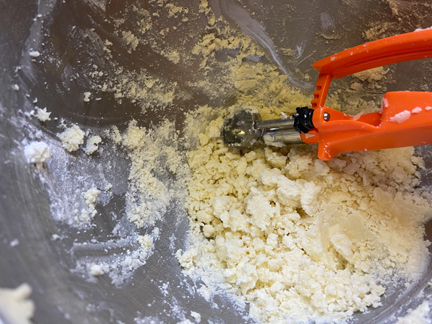
The problem, as you can see from the list of ingredients below and the photo above, is that a lot of the Peppermint Meltaway cookie dough is made up of two very crumbly substances, confectioner’s sugar and cornstarch.
In addition, the cookies have no egg to bind them. Even after one chills the dough for an hour, it can be difficult to shape into balls. They really DO need to be shaped into firm balls, however.
I tried just forming a few very delicately, thinking they would be okay once they went into the oven. Unfortunately, those few cookies spread all over the place. If you persist and create firm balls, however, you will be rewarded with delicate cookies that live up to their name by melting in your mouth.
I should think they would be even prettier if one were to tint the icing on top a pretty pink. In the absence of food coloring (mine is hiding somewhere in my pantry), the white icing does just fine. After all, the crushed candy canes provide a welcome hint of color.
Please note that the peppermint flavor in the cookies and the icing comes from peppermint extract, not peppermint oil. If you have only peppermint oil, be aware that it is much more concentrated than the extract so you’ll need only a few drops.
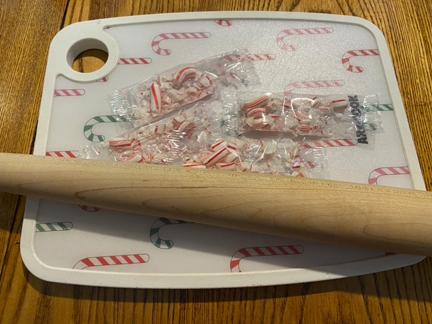
Peppermint Meltaways
(adapted from Land O Lakes)
Ingredients:
for the cookies:
1-1/4 cups flour
1/2 cup cornstarch
1 cup (2 sticks) sweet butter at room temperature
1/2 cup confectioner’s sugar
1/2 teaspoon peppermint extract
for the icing:
1/4 cup (1/2 stick) softened sweet butter
3/4 cup confectioner’s sugar, plus more if needed
1 teaspoon peppermint extract
milk if necessary to stir
for finishing:
crushed candy canes as needed
Instructions:
Begin by making the cookies. In a small bowl, whisk together the flour and the cornstarch. Set them aside.
In another mixing bowl, cream together the butter and the confectioner’s sugar. Beat in the extract. Slowly add the flour/cornstarch mixture and blend well. Push down on the dough with your hands to help it hold together. Cover the bowl, and refrigerate the dough for an hour.
Preheat the oven to 350 degrees. Line 2 baking sheets with parchment. Form the dough into 1-inch (or slightly larger) balls, pressing each ball gently but firmly to help it stick together. Place the balls 2 inches apart on the baking sheets.
Bake the cookies for 10 to 12 minutes, until the edges just start to turn brown. Remove the cookie sheets from the oven, and allow the cookies to cool completely.
When the cookies are cool, beat together the frosting ingredients. Adjust the consistency by adding a little more softened butter, a little more confectioner’s sugar, and/or a little milk to make sure you have a spreadable frosting. Gently spread a little frosting on each cooled cookie.
Top the cookies with a little crushed peppermint. This can be messy because the crushed candy wants to go everywhere except on top of the cookies, but persist. You’ll end up with very pretty cookies. Makes about 30 festive cookies.
